Birds (including free flight)
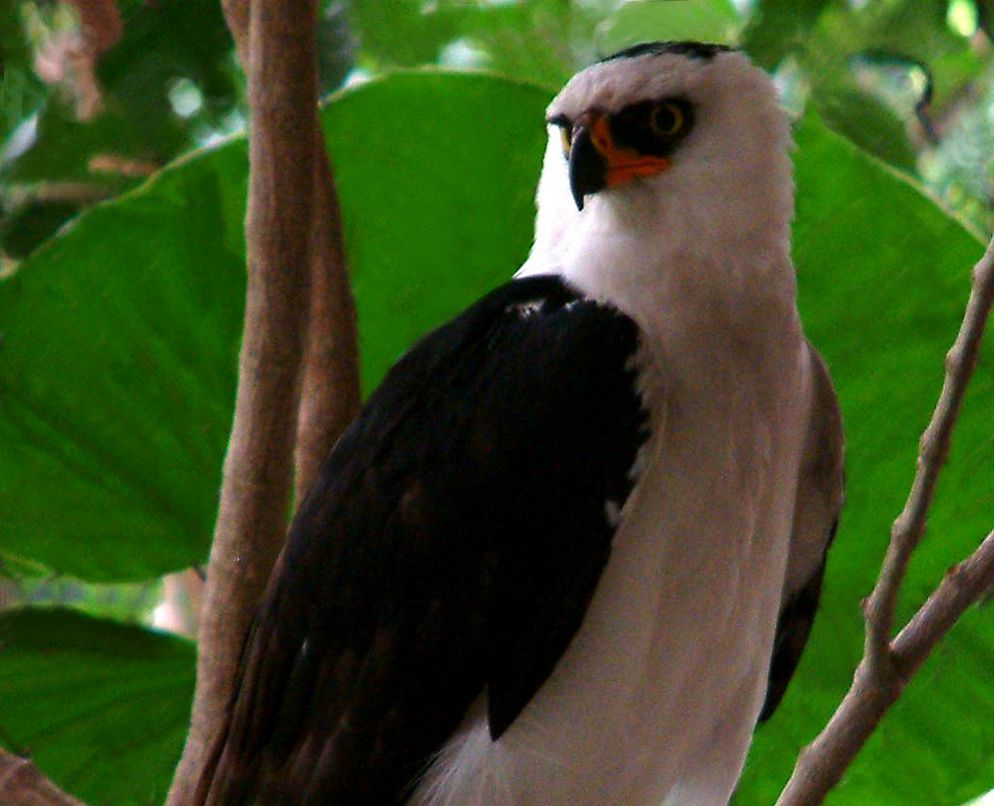
Black-and-white hawk-eagle, Spizastur melanoleucus
The Black and white hawk-eagle as the name suggests, is a black and white eagle with a small crest that forms a “skullcap-like” black spot on its head. Its head, neck and body are white, the wings are brownish-black and the grayish-brown tail is barred. The cere is orange and the eyes are yellow. The beak has a black tip. The feet are bright yellow with black talons. The sexes are similar, but females are larger.
LEARN MORE
Scarlet macaw, Ara macao
This marvelous parrot was one of the first New World animals brought alive to Europe, in the 1500s. Long before, it was prized as a pet, and for its feathers, by many Native American cultures. Live birds were traded to Arizona and New Mexico from Mexico for more than 700 years. Known as Mo to the Mayans, it was revered by their Kings, some of who wore rubber rings on their faces in honor of it. Threatened in Mexico and Central America, it remains common in much of South America. First hatched in the US in 1916, it breeds well in captivity.
LEARN MORE
Purple-throated fruitcrow, Querula purpurata
Despite their name, the several species of fruitcrows are not related to crows at all, though they do eat many kinds of fruit, which they gather both while in flight and perching in trees. Like many other members of the cotinga family, the males have a distinctive display, courting the all black females by flaring out their brilliant throat feathers (which can appear bright red), shaking their tails back and forth and making piercing calls. A relative of the Cock-of-the-rock, this species has only rarely been kept in captivity, despite being found over a vast area of South America, as well as Costa Rica and Panama. It was not bred in a zoo until 2006, when the Wuppertal Zoo in Germany was successful.
LEARN MORE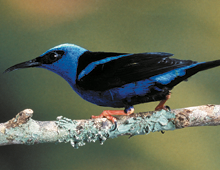
Red-legged honeycreeper, Cyanerpes cyaneus
Honeycreepers are tanagers adapted to drinking nectar, and are sometimes mistaken for hummingbirds due to their slender beaks and continual busyness. Found from Mexico to Southern Brazil, for decades this species has been popular in zoos and private aviaries where they have been bred for more than 60 years. Unusual among tanagers, males molt out their brilliant blue and black pattern for part of the year, resembling the streaky green females. Both have bright yellow feathers concealed under their wings that are visible when in flight.
LEARN MORE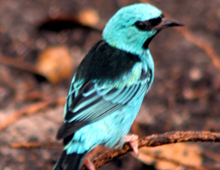
Blue dacnis, Dacnis cayana
The nine species of Dacnis are specialized small tanagers that hunt for insects, eat berries and drink nectar. While some of them are rare, the Blue dacnis has an enormous distribution across South America, as well as southern Central America. It is a common species in zoos, and has been known as cage bird for more than a hundred years. While only the males have the bright blue and black pattern, females are also brilliantly colored, in bright greens and blues.
LEARN MORE
Violaceous euphonia, Euphonia violacea
With 27 species, the Euphonias comprise another very large genus of Tropical American Birds. They are found from the Mexican State of Sonora, down to Argentina and Bolivia, as well as a number of Caribbean islands. The DWA has exhibited several species. Long considered tanagers, they have been recently reclassified as finches. This species, found over a large area of eastern South America, has been a popular bird in private collections and zoos since the Victorian era. It has bred at the DWA.
LEARN MORE
Bay-headed tanager, Tangara gyrola
This is one of the more widely distributed of the Tangara tanagers, found from Costa Rica south through a large area of South America, including parts of the Andes, Amazonia and Eastern Brazil. It has been an admired cage bird for at least a century, and is one of the more common tanagers in zoos, where it has been bred.
LEARN MORE
Silver-throated tanager, Tangara icterocephala
One of the more northern members of its genus, this species is found from Costa Rica south to Ecuador, following the Andes in its South American Range. The specimens at DWA were collected in Panama. Chicks were raised by their parents in Mundo Maya in 2011.
LEARN MORE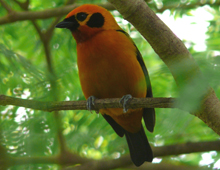
Golden tanager, Tangara arthus
There are at least 47 species of small, jewel-like tanagers in the genus Tangara, making this the largest genus of purely Tropical American birds. The DWA displays more than a dozen, probably the most extensive public exhibit. They are particularly concentrated along the Andes, as is this species, which is found from Venezuela to Bolivia. Although now seldom seen in zoos, it has bred repeatedly in captivity since the 1950s.
LEARN MORE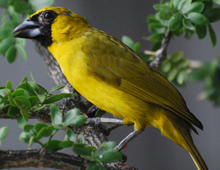
Yellow-green grosbeak, Caryothraustes canadensis
Carl Linnaeus (1707-1778) invented the scientific names we use today. Many of his names were given to dead specimens in European museums, or pictures in books, so the information he had was sometimes incorrect. The laws of nomenclature do not allow for corrections. Thus, even though this large finch actually comes from Panama and Northern South America, the “Canadian” name that Linneaus gave it in in 1766 is still used. A relative of the Cardinal, Rose-breasted grosbeak, and Painted and Indigo buntings, it has always been rare in captivity.
LEARN MORE

